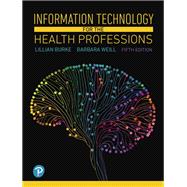For courses in computers and technology in health care.
Innovative applications of health care IT in the health professions
Information Technology for the Health Professions examines the myriad uses of computers and information technology in health care. Clear and comprehensive, it explores the applications of healthcare IT across health professions, including medical administration, telemedicine, public health, radiology, surgery, pharmacy, dentistry, and rehabilitation. Students will learn about rapid technological advances shaping health care delivery, federal laws impacting health care IT, and strategies for protecting patient privacy. The 5th edition explores new innovations in health care IT, such as teledentistry, robotic surgery, light imaging technology in radiology, and CRISPR, a technology improving gene editing.











